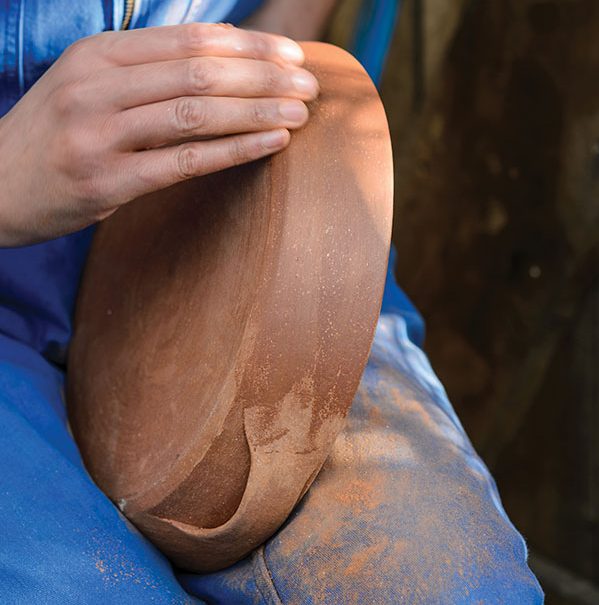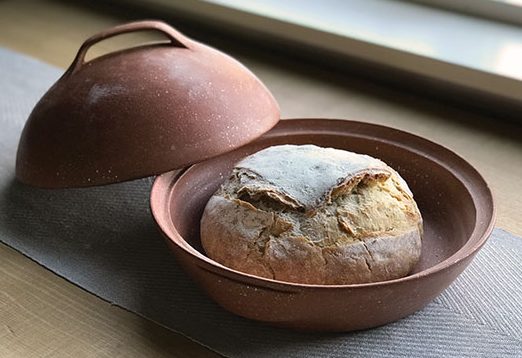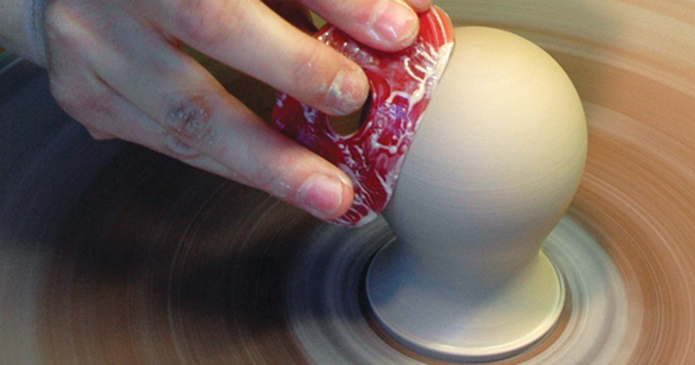How to Make a Bread Cloche

When Isatu Hyde had a studio above a cafe in London, she became inspired to create lidded baking dishes for baking bread, inspired by the cast iron pots the chef used. And with the sourdough baking craze brought on by the pandemic, she has continued to have a high-demand for them.
In today’s post, an excerpt from the Ceramics Monthly archive, Isatu shares how she makes these simple, beautiful, functional forms from micaceous clay, a clay body particularly suited for cooking pots.
PS. For more about the clay body and Isatu’s path to developing this line of work, check out the December 2020 issue of Ceramics Monthly!
Making a Bread Cloche
Weighing out the clay first is important to ensure consistency of form . The next step is wedging the clay—I do this for every piece, even if the clay has been pugged. The clay can be a little stubborn and quickly gets tired, so it’s a good idea to prepare the clay properly.
I throw the cloches on bats to avoid distortion while being lifted off the wheel. Creating concentric clay rings on the wheel head allows me to fix the bat down temporarily (1).




Begin by throwing the cloche bases first. I always check the depth of the base with a needle (2) because when first developing this design, cracks formed in many of the cloches, which was partly due to my bases being too thick compared to the walls. This caused uneven drying and shrinkage, resulting in cracks.
The larger of the two cloche sizes I make has a diameter of up to 12½ in. (32 cm), so being careful with widening the opening in the clay while throwing is really important (3). I take my time and compress the base with my fingers a lot as I go (4).
Next, create a ledge or gallery on the inside wall for the lid to sit on. I begin forming this profile early on and then refine it with a square-edged tool later (5). Immediately after throwing is complete, I cut the base from the bat, which really helps to minimize cracking, and then leave it to dry to leather hard (6).




Next, make the matching lid. Getting the lids to fit the bases can be a bit of a complicated task. Making them successively, right after throwing the base, lessens the chance of shrinkage miscalculations later on. The lid is simply thrown as a bowl and trimmed later to a smooth dome with no foot ring. I begin bowl forms by throwing a flared cone shape, and then gradually bellying it out (7, 8). Getting the lids to accurately fit the bases is a matter of millimeters and requires lots of checking with calipers to compare the diameter of the lid to the diameter of the gallery ledge (9).
I pull two handles for each base and one larger one for the lid (10). After the pieces have been trimmed and the handles have been attached, they’re left to dry out completely.
Once I’m sure they’re bone dry, I sand both the lid and body of the cloche with two grits of sandpaper until the surface is beautifully matte and smooth (11). Next, I lightly burnish them with a thick, sieved slip of the same clay. I use a dry sponge to burnish and work my way quickly around the pots.
It is essential that everything dries completely because micaceous clay has a tendency to blow up in the firing if it’s not dry. I fire in an electric kiln, start heating slowly, and go up to cone 08 (12).




the author Isatu Hyde is a full-time potter and designer living and working in Shropshire, UK. She apprenticed with Andrew Crouch at The Marches Pottery in Ludlow, Shropshire. To learn more, visit www.isatuhyde.comor follow her on Instagram @isatuhyde







